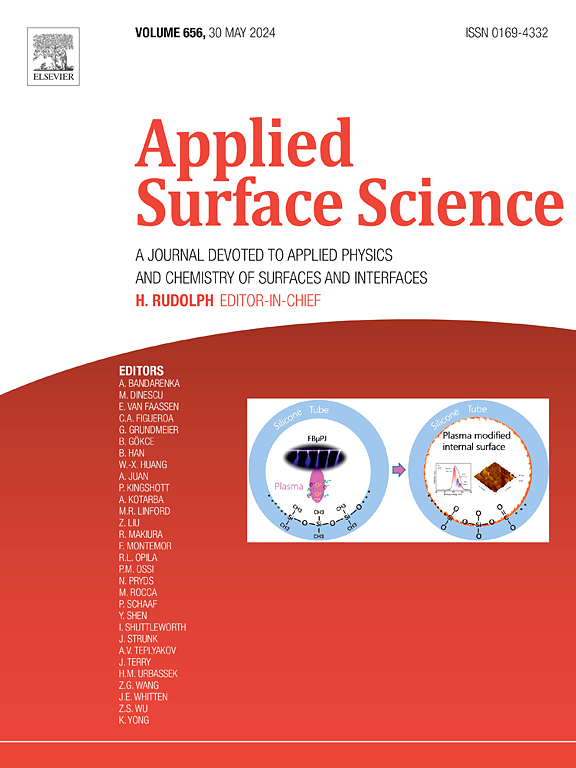通过胶束动力学的含油微滴双相涂层:超低摩擦和屏蔽填料/树脂界面的脆弱性
IF 6.3
2区 材料科学
Q2 CHEMISTRY, PHYSICAL
引用次数: 0
摘要
固体填料增强环氧涂料面临两个固有的挑战:实现持久的超低摩擦(μ <; 0.05)和防止高活性树脂/填料界面的界面降解。利用油相组分固有的疏水性、缺陷补偿能力和边界润滑潜力,本研究开发了一种液相强化策略来解决界面挑战。本研究将油性氧化石墨烯(TG)微滴(T-G)通过胶束加载-解吸法均匀分散在环氧树脂(EP)中,得到油固两相涂层(T-G/EP)。通过微弧氧化(MAO)层间集成进一步增强了系统,建立了协同保护体系(T-G/EP-on-MAO)。与EP相比,T-G/EP-on- mao的摩擦系数降低了92.13% %(从0.623降至0.049),磨损率降低了59.52% %(从16.947 × 10−5降至6.860 × 10−5 mm3/N·m)。这种增强来自于在滑动界面处原位形成的油基润滑膜。经过4周的电化学测试,T-G/EP-on-MAO的log(Rc)值最高(Rc = 涂层阻力)为7.42。分子动力学模拟揭示了双重保护机制:(1)油微滴通过增强分子堆积抑制自由体积,同时降低水扩散系数;(ii)水渗透优先诱导分子间氢键,而不是与高反应性原子在TG/树脂界面的相互作用,从而屏蔽填料/树脂界面的脆弱性,限制水的流动性。本文章由计算机程序翻译,如有差异,请以英文原文为准。

Oil microdroplet-containing biphasic coatings via micellar dynamics: ultra-low friction and shielding of filler/resin interfacial fragility
Solid filler-reinforced epoxy coatings face two inherent challenges: achieving durable ultra-low friction (μ < 0.05) and preventing interfacial degradation at highly reactive resin/filler interfaces. Harnessing the intrinsic hydrophobicity, defect-compensation capability, and boundary lubrication potential of oil-phase components, this study develops a liquid-phase reinforcement strategy to address the interfacial challenges. Here, oily graphene oxide (TG) microdroplets (T-G) were uniformly dispersed in epoxy resin (EP) via a micellar loading-desorption method, yielding an oil-solid biphasic coating (T-G/EP). The system was further enhanced through micro-arc oxidation (MAO) interlayer integration, establishing a synergistic protective architecture (T-G/EP-on-MAO). T-G/EP-on-MAO exhibited a 92.13 % reduction in friction coefficient (from 0.623 to 0.049) and a 59.52 % decrease in wear rate (from 16.947 × 10−5 to 6.860 × 10−5 mm3/N·m) compared to EP. This enhancement originates from the in situ formation of an oil-based lubricant film enhanced by TG at sliding interfaces. After four weeks of electrochemical testing, T-G/EP-on-MAO exhibited the highest log(Rc) value (Rc = coating resistance) of 7.42. Molecular dynamics simulations unveiled dual protective mechanisms: (i) Oil microdroplets suppress free volume through enhanced molecular packing, concurrently reducing water diffusion coefficients; (ii) Water infiltration preferentially induces intermolecular hydrogen bonding over interactions with highly reactive atoms at TG/resin interfaces, thereby shielding the filler/resin interfacial fragility and restricting water mobility.
求助全文
通过发布文献求助,成功后即可免费获取论文全文。
去求助
来源期刊

Applied Surface Science
工程技术-材料科学:膜
CiteScore
12.50
自引率
7.50%
发文量
3393
审稿时长
67 days
期刊介绍:
Applied Surface Science covers topics contributing to a better understanding of surfaces, interfaces, nanostructures and their applications. The journal is concerned with scientific research on the atomic and molecular level of material properties determined with specific surface analytical techniques and/or computational methods, as well as the processing of such structures.
 求助内容:
求助内容: 应助结果提醒方式:
应助结果提醒方式:


